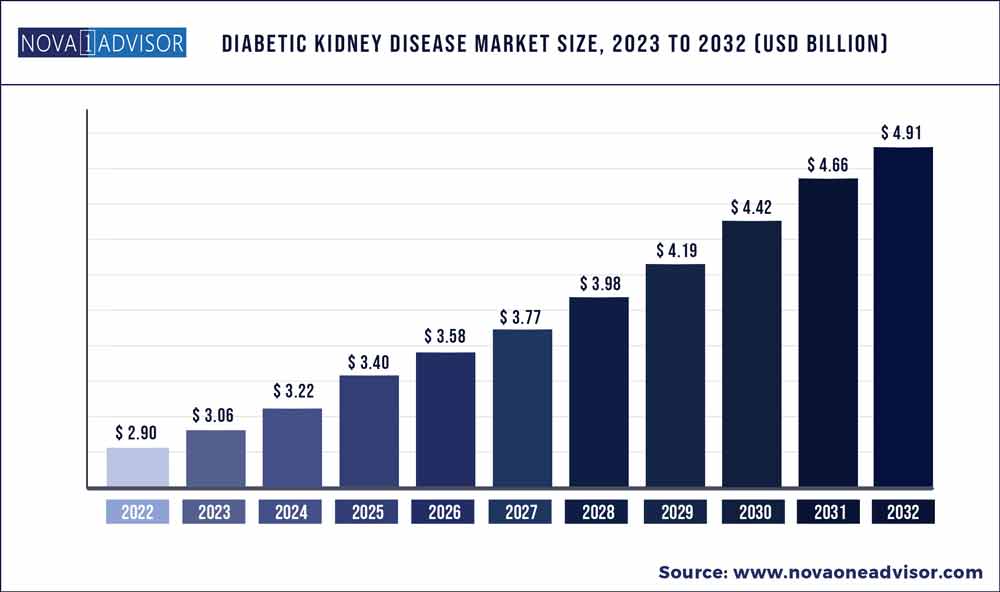The global diabetic kidney disease market size was exhibited at USD 2.9 billion in 2022 and is projected to hit around USD 4.91 billion by 2032, growing at a CAGR of 5.4% during the forecast period 2023 to 2032.

Key Pointers:
- On the basis of type, the type 2 segment is anticipated to maintain its market dominance with the highest market share from 2023 to 2032.
- On the basis of treatment, the angiotensin-converting enzyme (ACE) Inhibitors segment has the largest market share.
- On the basis of distribution channels, the retail pharmacy and drug store segment contributed the highest revenue in 2022.
- On the basis of geography, the North America region captured the largest market share in 2022.
Diabetic Kidney Disease Market Report Scope
Diabetic nephropathy is a long-term kidney disease that can affect people with diabetes. It occurs when high blood glucose levels damages kidney functions. It can occur in people with type-2 diabetes. Diabetic nephropathy is caused by damage to the tiniest blood vessels. When small blood vessels begin to develop damage, both kidneys begin to leak proteins into the urine. As damage to the blood vessels continues, the kidneys gradually lose their ability to remove waste products from the blood. It occurs when high blood glucose levels damage kidney function. Up to 40% of people with type-1 diabetes eventually develop significant kidney diseases, which sometimes requires dialysis or a kidney transplant. Only 4 to 6 % of all type-2 diabetes patients end up requiring dialysis, although about 20–30% of people with type-2 diabetes develop at least some kidney damage. About 40% of all people who need to start dialysis have kidney failure from type-1 or type-2 diabetes.
The diabetic nephropathy is diagnosed by different test such as urinary albumin test, albumin/creatinine ratio, and glomerular filtration rate (GFR), and other special tests includes imaging tests (CT scanning, MRI) and Kidney biopsy.
The major factors that drive the diabetic nephropathy market is surge in number of geriatric populations suffering from diabetic nephropathy, continuous increase in range of conditions that can be treated by diabetic nephropathy medicine and rise in demand of anti-diabetic medicine. This market also increased due to rise in incidence rates of various kidney diseases and rise in testing, which are expected to offer lucrative opportunities for market expansion.
Diabetic nephropathy can be controlled by taking medication, low protein diet, adopt healthy lifestyle, exercise and proper checkup that are preventing from kidney failure. Furthermore, diabetic nephropathy medicine work by controlling the blood glucose level, lowering cholesterol level and lowering to high blood pressure (hypertension). Due to wide application of diabetic nephropathy medicine and increasing the diagnostic tests of diabetic nephropathy are led to the growth of diabetic nephropathy market share. Moreover, increase in initiatives by governments & non-governmental organizations to promote awareness about diabetic nephropathy significantly contributes toward the growth of the industry.
However, the sales of diabetic nephropathy medicine have witnessed hindrances, owing to lack of skilled professionals for treatment of diabetic nephropathy in emerging and less developed countries, poor planning of diabetic nephropathy treatment in low-income countries are the key factors restraining the market. Strict regulatory rules regarding selling and lengthy approval time for drugs for diabetic nephropathy are also hamper the market growth. Due to these factors, the sales of premium diabetic nephropathy product are minimum. Conversely, the introduction of new medicine of diabetic nephropathy into developing nations is anticipated to offer remunerative opportunities for the expansion of the global market during the forecast period.
Furthermore, the healthcare business in developing nations is predicted to grow significantly as a result of various reasons, including increased investment in both the public and private sectors, rise in chronic diseases, surge in number of diabetes cases, and population expansion. Furthermore, an increase in healthcare spending is expected to promote the expansion of the healthcare business, which, in turn, is expected to fuel product demand.
The significant reduction in clinical trials due to strict government guidelines against COVID-19. Dialysis and transplant of kidney operation in diabetic nephropathy patient were postponed and home care setting care was preferred. Furthermore, the lockdown led to the disruption of manufacturing and transportation of healthcare essentials. According to FDA data that was published in 2019, approximately 40% pharmaceutical manufacturing unit established in India and China for the active pharmaceutical ingredient. Therefore, it has severely impacted to the supply chain of drugs.
Some of the prominent players in the Diabetic Kidney Disease Market include:
- AstraZeneca (UK.)
- Pfizer Inc (US.)
- Allergan,Inc (Ireland)
- Bristol-Myers Squibb Company (US.)
- Endo International plc (Ireland)
- Dr. Reddy's Laboratories Ltd (India)
- Sun Pharmaceutical Industries Ltd (India)
- Teva Pharmaceutical Industries Ltd (Israel)
- Novartis AG (Switzerland)
- Mylan NV (US.)
- CiplaInc (India)
- Lupin (India)
- Aurobindo Pharma (India)
- Sanofi (France)
- Fresenius SE & Co. KGaA (Germany)
- F. Hoffmann-La Roche Ltd (Switzerland)
- Takeda Pharmaceutical Company Limited (Japan)
- Abbott (US.)
Segments Covered in the Report
This report forecasts revenue growth at global, regional, and country levels and provides an analysis of the latest industry trends in each of the sub-segments from 2018 to 2032. For this study, Nova one advisor, Inc. has segmented the global Diabetic Kidney Disease market.
By Type
- Type 1 Diabetes
- Type 2 Diabetes
By Treatment
- Angiotensin Receptor Blockers (ARBs)
- Angiotensin-Converting Enzyme (ACE) Inhibitors
- Antioxidant Inflammation Modulator
- Calcium Channel Blockers
- Others
By Distribution Channel
- Online Pharmacy
- Hospital Pharmacy
- Retail Pharmacy
By Region
- North America
- Europe
- Asia-Pacific
- Latin America
- Middle East & Africa (MEA)

